Abstract
A multicore from Emerald Basin, on the continental margin off Nova Scotia, has a modern 14C age at the top, and other 14C dates indicate a linear sedimentation rate of ∼30 cm/ka to 1600 calendar years BP. This rate is great enough to record century-to-millennial scale changes in the surface and deep (∼250 m) waters in the basin that are influenced by the Labrador Current. We applied five proxies for seawater temperature changes to the sediments of Emerald Basin, including the percent abundance and the oxygen isotope ratio (δ18O) of the polar planktonic foraminifer N. pachyderma (s.), the unsaturation ratio of alkenones (Uk′ 37) produced by prymnesiophyte phytoplankton, and the δ18O and Mg/Ca of benthic foraminifera. All five proxies indicate the ocean warmed suddenly sometime in the past 150 years or so. The exact timing of this event is uncertain because 14C dating is inaccurate in recent centuries, but this abrupt warming probably correlates with widespread evidence for warming in the Arctic in the nineteenth century. Because the Canadian Archipelago is one of the two main sources for the Labrador Current, warming and melting of ice caps in that region may have affected Labrador Current properties. Before this recent warming, sea surface temperature was continually lower by 1–2 °C, and bottom water was colder by about 6 °C in Emerald Basin. These results suggest that there was no Medieval Warm Period in the coastal waters off Nova Scotia. Because there is also no evidence of medieval warming in the Canadian archipelago, it seems likely that coastal waters from Baffin Bay to at least as far south as Nova Scotia were continually cold for ∼1500 of the past 1600 years.






Similar content being viewed by others
References
Bemis BE, Spero HJ, Bijma J, Lea DW (1998) Reevaluation of the oxygen isotopic composition of planktonic foraminifera: experimental results and revised paleotemperature equations. Paleoceanography 13: 150–160
Boyle EA, Keigwin LD (1985/86) Comparison of Atlantic and Pacific paleochemical records for the last 215,000 years: changes in deep ocean circulation and chemical inventories. Earth Planet Sci Lett 76: 135–150
Dansgaard W, Johnsen SJ, Reeh N, Gundestrup N, Calusen HB, Hammer CU (1975) Climatic changes, Norsemen and modern man. Nature 255: 24–28
deMenocal P, Ortiz J, Guilderson T, Sarnthein M (2000) Coherent high- and low-latitude climate variability during the Holocene warm period. Science 288: 2198–2202
Dyke AS, England J, Reimnitz E, Jette H (1997) Changes in driftwood delivery to the Canadian Arctic Archipelago: the hypothesis of postglacial oscillations of the Transpolar Drift. Arctic 50: 1–16
Gatien MG (1976) A study in the slope water region south of Halifax. J Fish Res Board Can 33: 2213–2217
Herbert TD (2001) Review of alkenone calibrations (culture, water column, and sediments). Geochem Geophys Geosyst 2: 2000GC000055
Jennings AE, Weiner NJ (1996) Environmental change in eastern Greenland during the last 1300 years: evidence from foraminifera and lithofacies in Nansen Fjord, 68°N. The Holocene 6: 179–191
Keigwin LD (1996) The little ice age and medieval warm period in the Sargasso Sea. Science 274: 1504–1508
Khatiwala SP, Fairbanks RG, Houghton RW (1999) Freshwater sources to the coastal ocean off northeastern North America: evidence from H2 18O/H2 16O. J Geophys Res 104: 18,241–18,255
King LH, Fader GBJ (1986) Wisconsinan glaciation of the Atlantic continental shelf of southeast Canada. Geological Survey of Canada, pp 1–72
Koerner RM (1977) Devon Island ice cap: core stratigraphy and paleoclimate. Science 196: 15–18
Koerner RM, Fisher DA (1990) A record of Holocene summer climate from a Canadian high-Arctic ice core. Nature 343: 630–631
Kohfeld KE, Fairbanks RG, Smith SL, Walsh ID (1996) Neogloboquadrina pachyderma (sinistral coiling) as paleoceanographic tracers in polar oceans: Evidence from Northeast Water Polynya plankton tows, sediment traps, and surface sediments. Paleoceanography 11: 679–699
Kontopoulos N, Piper DJW (1982) Storm graded sand at 200 m water depth, Scotian Shelf, eastern Canada. Geo-Marine Lett 2: 77–81
Lazier JRN, Wright DG (1993) Annual velocity variations in the Labrador Current. J Phys Oceanogr 23: 659–678
Lear CH, Rosenthal Y, Slowey N (2002) Benthic foraminiferal Mg/Ca-paleothermometry: a revised core-top calibration. Geochim Cosmochim Acta (in press)
Levac E (2001) High resolution Holocene palynological record from the Scotian Shelf. Mar Micropaleo 43: 179–197
Loder JW, Petrie B, Gawarkiewicz G (1998) The coastal ocean off northeastern North America: a large-scale view. In: Robinson AR, Brink KH (eds) The sea. John Wiley, 11, pp 105–133
Müller PJ, Kirst G, Ruhland G, von Storch I, Rosell-Mele A (1998) Calibration of the alkenone paleotemperature index Uk′ 37 based on core-tops from the eastern South Atlantic and the global ocean (60°N–60°S). Geochim Cosmochim Acta 62: 1757–1772
Overpeck J, Hughen K, Hardy D, Bradley R, Case R, Douglas M, Finney B, Gajewski K, Jacoby G, Jennings A, Lamoureux S, Lasca A, MacDonald G, Moore J, Retelle M, Smith S, Wolfe A, Zielinski G (1997) Arctic environmental changes of the last four centuries. Science 278: 1251–1256
Petrie B, Drinkwater K (1993) Temperature and salinity variability on the Scotian Shelf and in the Gulf of Maine 1945–1990. J Geophys Res 98: 20,079–20,089
Piper DJW, Fehr SD (1991) Radiocarbon chronology of late Quaternary sections on the inner and middle Scotian Shelf, south of Nova Scotia. Current Research, Part E; Geological Survey of Canada, pp 321–325
Prahl FL, Muehlhausen L, Zahnle D (1988) Further evaluation of long-chain alkenones as indicators of paleocenaographic conditions. Geochim Cosmochim Acta 52: 2303–2310
Proshutinsky AV, Johnson MA (1997) Two circulation regimes of the wind-driven Arctic Ocean. J Geophys Res 102: 12,493–12,514
Rosenthal Y, Field P, Sherrell R (1999) Precise determination of element/calcium ratios in calcareous samples using sector field inductively coupled plasma mass spectrometry. Analyt Chem 71: 3248–3253
Sachs JP, Lehman SJ (1999) Subtropical North Atlantic temperatures 60,000 to 30,000 years ago. Science 286: 756–759
Scott DB, Mudie PJ, Vilks G, Younger DC (1984) Latest Pleistocene–Holocene paleoceanographic trends on the continental margin of eastern Canada: foraminiferal dinoflagellate and pollen evidence. Mar Micropaleo 9: 181–218
Sikes EL, Volkman JK, Robertson LG, Pichon J-J (1997) Alkenones and alkenes in surface waters and sediments of the Southern Ocean: implications for paleotemperature estimation in polar regions. Geochim Cosmochim Acta 61: 1495–1505
Tremblay L-B, Mysak LA, Dyke AS (1997) Evidence from driftwood records for century-to-millennial scale variations of the high latitude atmospheric circulation during the Holocene. Geophys Res Lett 24: 2027–2030
Vilks G, Rashid MA (1976) Post-glacial paleo-oceanography of Emerald Basin, Scotian Shelf. Can J Earth Sci 13: 1256–1267
Acknowledgements.
We acknowledge NSF grants OCE9709686 to LDK for OCE voyage 326 and associated laboratory work, and OCE9819675 to YR. We acknowledge the MIT Wade Fund and a Doherty Professorship for providing funding for this work to JPS. We also thank Eben Franks for his coring skills at sea, and for his operation of the mass spectrometer, and Ellen Roosen for her micropaleontology skills; Ying Chang for assistance with alkenone analyses; the AMS facility at WHOI, Ken Buesseler for 210Pb dating; and Kate Moran, David Piper, and Iris Hardy for discussions about core locations on the Canadian margin and for providing samples. In particular, Kate Moran recommended the location of MC-29. We thank David Piper and Lawrence Mysak for reviews of the manuscript, and Mysak's suggestion to add Fig. 6.
Author information
Authors and Affiliations
Corresponding author
Rights and permissions
About this article
Cite this article
Keigwin, L.D., Sachs, J.P. & Rosenthal, Y. A 1600-year history of the Labrador Current off Nova Scotia. Climate Dynamics 21, 53–62 (2003). https://doi.org/10.1007/s00382-003-0316-6
Received:
Accepted:
Published:
Issue Date:
DOI: https://doi.org/10.1007/s00382-003-0316-6




